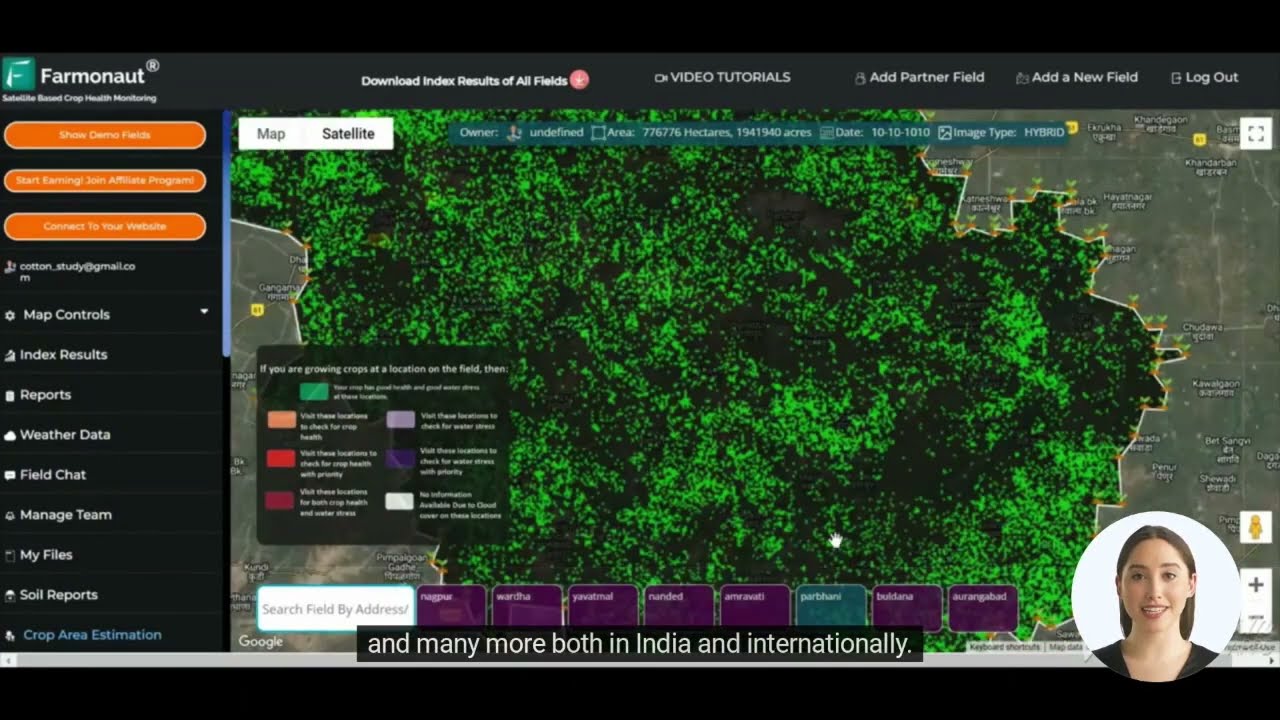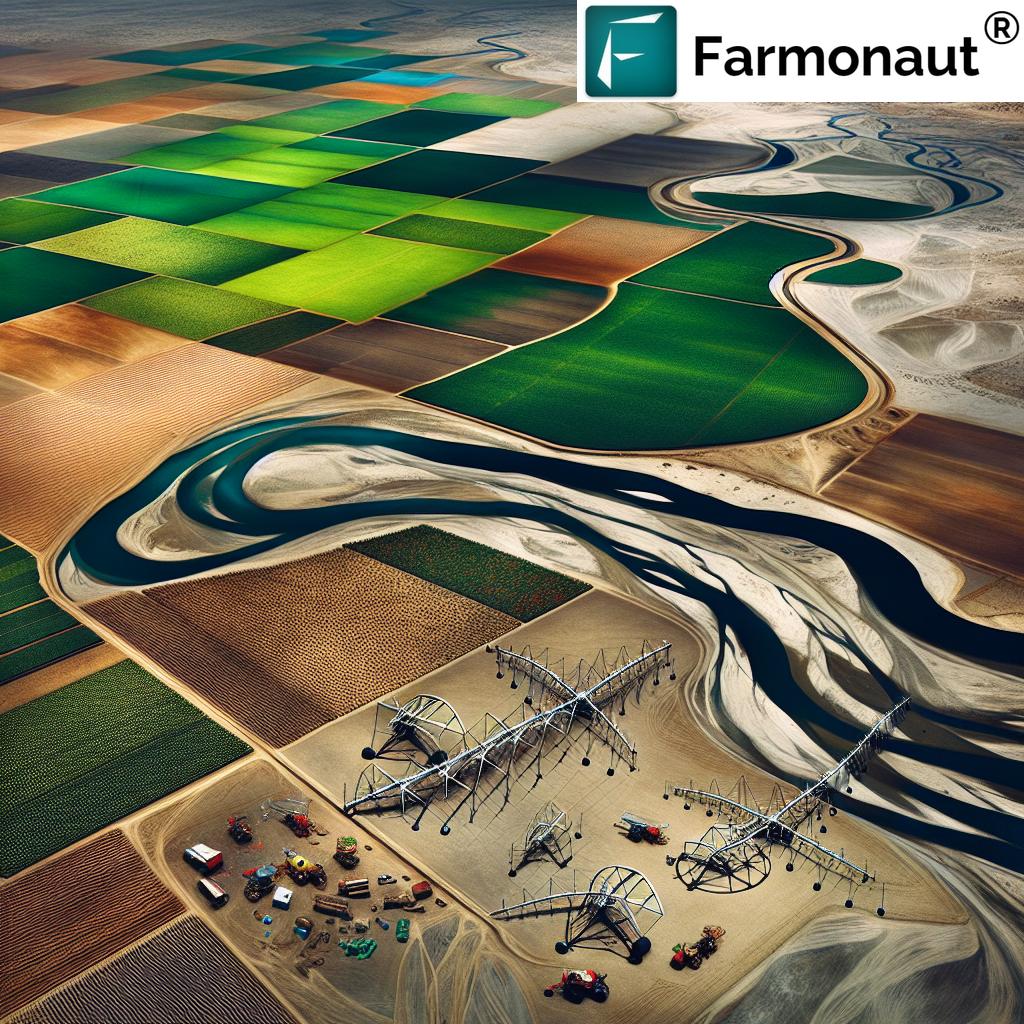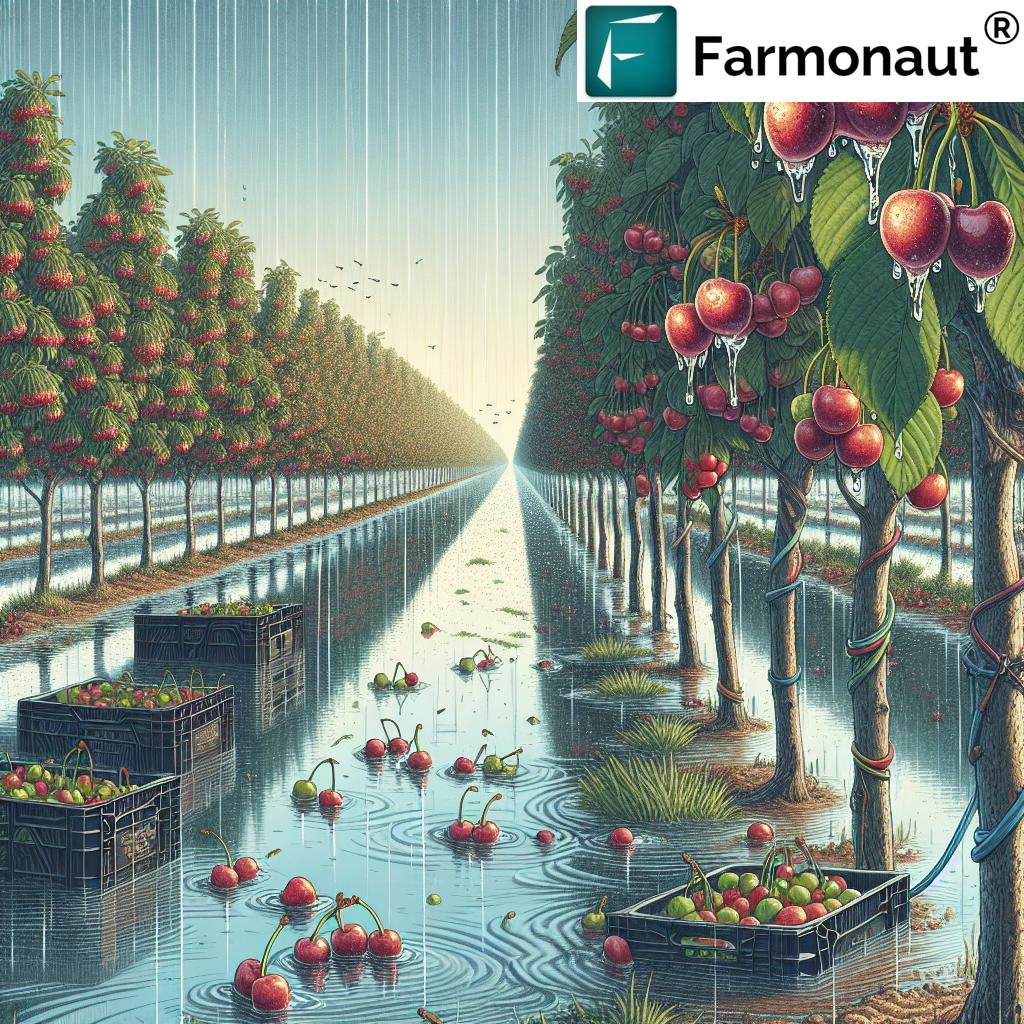Kansas Water Crisis: Balancing Agriculture and Sustainability in the Face of Drought

“Kansas farmers irrigate approximately 3 million acres, consuming about 3 trillion gallons of water annually.”
In the heart of America’s breadbasket, Kansas is facing a critical water crisis that threatens the very foundation of its agricultural legacy. As we delve into the complexities of Kansas water conservation efforts and the ongoing struggle against drought conditions, we find ourselves at a pivotal moment in the state’s history. The balance between agricultural needs and environmental sustainability has never been more precarious, and the solutions we seek are as complex as the problem itself.
We at Farmonaut, as experts in remote sensing and agricultural technology, understand the intricate relationship between water management and sustainable farming practices. Our satellite-based farm management solutions provide valuable insights into crop health, soil moisture, and resource utilization, making us uniquely positioned to contribute to this pressing discussion.
The Current State of Kansas Water Resources
Recent winter snows have provided a temporary reprieve from the persistent drought conditions plaguing Kansas, particularly in the Central and Western regions. However, this momentary relief does little to address the long-term concerns about water availability and sustainability in agriculture. The state’s water infrastructure and usage patterns are under intense scrutiny as policymakers, farmers, and citizens grapple with the realities of a changing climate and depleting groundwater resources.
- Groundwater depletion in key aquifers
- Increasing frequency and severity of drought conditions
- Rising demand for irrigation in agriculture
- Aging water infrastructure in rural communities
The Ogallala Aquifer, which supplies approximately 70% of Kansas’ irrigation water, has seen alarming declines in recent years. This vital water source, once considered an inexhaustible resource, is now showing signs of severe depletion, with some areas experiencing declines of up to 60%.
The Impact of Drought on Kansas Communities
The effects of drought conditions in Kansas extend far beyond the farm fields. Rural communities are feeling the strain as wells run dry and water quality issues become more prevalent. In Reno County, for instance, residents are facing unprecedented challenges in securing reliable water sources.
Miller Drilling, a company based in Hutchinson, reports a surge in demand for new wells. Many residents are finding that their existing wells, once sufficient for their needs, are no longer reaching the water table. This has led to a dramatic increase in well depths, with some new wells being drilled as deep as 200 feet to reach water.
These changes raise significant concerns about:
- Property values in affected areas
- The long-term viability of rural communities
- The economic impact on local businesses and agriculture
- The sustainability of current water usage practices
Agricultural Irrigation: The Double-Edged Sword
At the heart of Kansas’ water crisis lies the complex issue of agricultural irrigation. While irrigation has been instrumental in transforming Kansas into an agricultural powerhouse, it’s also the primary driver of water consumption in the state. Recent data shows that agricultural irrigation accounts for a staggering 83-84% of total water usage in Kansas.
This level of water consumption has led to visible changes in the landscape. Lawmakers like Joe Seiwert have witnessed firsthand the transformation of once-vibrant rivers into mere trickles, a stark testament to the impact of extensive irrigation practices on the state’s water resources.
However, it’s crucial to understand that farmers are not solely to blame for this situation. They are operating within a system shaped by state policies and economic necessities. The infamous “Use it or Lose it” rule, which has been a cornerstone of Kansas water management policy, has inadvertently encouraged overuse of water resources.
The “Use it or Lose it” Dilemma
The “Use it or Lose it” policy has long been a contentious issue in Kansas water management. This rule essentially requires farmers to use their full water permit allocations annually or risk losing those permits. While designed to prevent water hoarding, this policy has had the unintended consequence of encouraging water use even when it may not be necessary.
Governor Laura Kelly has openly criticized this policy, calling it a “dumb thing” and hinting at ongoing discussions to reform this practice. The challenge lies in finding a balance between conserving water resources and protecting the rights and livelihoods of farmers who depend on irrigation for their crops.
Steps Towards Sustainable Water Management
In response to these challenges, Kansas has begun implementing several initiatives aimed at promoting more sustainable water management practices:
- Multi-Year Flex Accounts: Introduced in 2012, these accounts allow farmers to allocate their water use over a five-year period more flexibly, encouraging conservation.
- Improved Irrigation Technologies: The adoption of more efficient irrigation systems, such as drip irrigation and precision agriculture techniques, is being promoted.
- Crop Diversification: Encouraging farmers to grow crops that are less water-intensive and more suited to the local climate.
- Groundwater Recharge Projects: Initiatives to replenish aquifers through various means, including improved land management practices.
At Farmonaut, we believe that technology has a crucial role to play in addressing these challenges. Our satellite-based crop monitoring systems can help farmers optimize their water use by providing real-time data on crop health and soil moisture levels. This data-driven approach to agriculture can lead to significant water savings without compromising crop yields.
The Role of Policy and Bipartisan Cooperation
Addressing Kansas’ water crisis requires more than just technological solutions; it demands a concerted effort from policymakers, farmers, and citizens alike. The state legislature has acknowledged the need for significant reforms, but reaching a consensus in a politically divided environment remains challenging.
Representative Jim Minnix, who chairs the Kansas House Committee on Water, recognizes the necessity of these changes. He points out that the culture of extensive water use needs to evolve, noting that the old mentality leading to wasteful practices is becoming outdated.
Progress has been made since 2021, including increased funding for water programs aimed at assisting small towns in improving their water infrastructure. However, more comprehensive reforms are needed to address the root causes of water depletion and ensure long-term sustainability.
“The Ogallala Aquifer, supplying 70% of Kansas’ irrigation water, has declined by up to 60% in some areas.”
Comparative Analysis of Water Management Strategies
To better understand the various approaches to water management in Kansas, let’s examine a comparative analysis of different strategies:
| Strategy Name | Description | Estimated Water Savings (acre-feet/year) | Impact on Agriculture | Implementation Challenges | Long-term Sustainability Score (1-10) |
|---|---|---|---|---|---|
| Current “Use it or Lose it” Policy | Requires full use of water permits annually | 0 | Low | Encourages overuse | 2 |
| Multi-Year Flex Accounts | Allows water allocation over 5-year periods | 50,000 – 100,000 | Medium | Requires careful planning | 7 |
| Improved Irrigation Technologies | Adoption of efficient irrigation systems | 100,000 – 200,000 | High | High initial costs | 9 |
| Crop Diversification | Growing less water-intensive crops | 75,000 – 150,000 | High | Market demand uncertainties | 8 |
| Groundwater Recharge Projects | Initiatives to replenish aquifers | 25,000 – 75,000 | Medium | Long-term process, high costs | 8 |
This comparison highlights the potential benefits and challenges associated with different water management approaches. It’s clear that a combination of strategies will be necessary to address Kansas’ water crisis effectively.
The Role of Technology in Water Conservation
As we navigate these complex water management issues, technology emerges as a powerful tool for conservation and efficient resource utilization. At Farmonaut, we leverage advanced satellite imagery and AI-driven analytics to provide farmers with crucial insights into their crop health and water needs.
Our platform offers several key benefits for water conservation in agriculture:
- Precision Irrigation: By providing accurate, real-time data on soil moisture levels and crop health, we enable farmers to apply water only where and when it’s needed most.
- Early Detection of Issues: Our satellite monitoring can identify potential problems in crop health early, allowing for targeted interventions that can save both water and crops.
- Data-Driven Decision Making: With access to historical and current data, farmers can make more informed decisions about crop selection, planting times, and irrigation schedules.
- Resource Optimization: Our AI-powered advisory system helps farmers optimize their resource use, including water, fertilizers, and pesticides.
Explore Farmonaut’s API for advanced agricultural data integration
The Future of Kansas Water Management
As we look to the future, it’s clear that addressing Kansas’ water crisis will require a multifaceted approach. This includes:
- Continued policy reform to encourage water conservation
- Investment in water-efficient technologies and infrastructure
- Education and outreach to promote water-conscious practices
- Collaboration between farmers, policymakers, and technology providers
- Long-term planning for climate change adaptation
The path forward will not be easy, but with concerted effort and innovative solutions, Kansas can achieve a balance between agricultural productivity and water sustainability. As a company committed to sustainable agriculture, Farmonaut stands ready to support farmers and policymakers in this crucial endeavor.
Check out our API Developer Docs for integration possibilities
Conclusion: A Call to Action
The Kansas water crisis is a complex challenge that touches every aspect of life in the state, from rural communities to urban centers, from individual farmers to large agribusinesses. As we’ve explored in this article, there are no easy solutions, but there is hope.
By embracing innovative technologies, implementing thoughtful policies, and fostering a culture of conservation, Kansas can secure its water future. This will require commitment and cooperation from all stakeholders, but the rewards – a sustainable agricultural sector, thriving communities, and a preserved natural environment – are well worth the effort.
We at Farmonaut are committed to being part of this solution, providing farmers with the tools and insights they need to optimize their water use and improve their crop yields sustainably. Together, we can turn the tide on water depletion and ensure a prosperous future for Kansas agriculture.
FAQ Section
Q: What is the main cause of water depletion in Kansas?
A: The primary cause of water depletion in Kansas is excessive agricultural irrigation, which accounts for 83-84% of the state’s total water usage.
Q: How has the “Use it or Lose it” policy affected water conservation in Kansas?
A: The “Use it or Lose it” policy has inadvertently encouraged overuse of water resources by requiring farmers to use their full water permit allocations annually or risk losing those permits.
Q: What are Multi-Year Flex Accounts, and how do they help conserve water?
A: Multi-Year Flex Accounts, introduced in 2012, allow farmers to allocate their water use over a five-year period more flexibly. This flexibility enables farmers to conserve water in wetter years and use more in drier years, promoting overall water savings.
Q: How can technology help in addressing Kansas’ water crisis?
A: Technologies like satellite-based crop monitoring systems can help farmers optimize their water use by providing real-time data on crop health and soil moisture levels. This data-driven approach can lead to significant water savings without compromising crop yields.
Q: What role does the Ogallala Aquifer play in Kansas agriculture?
A: The Ogallala Aquifer supplies approximately 70% of Kansas’ irrigation water. However, it has seen alarming declines in recent years, with some areas experiencing declines of up to 60%.
Earn With Farmonaut: Join our Affiliate Program
Earn 20% recurring commission with Farmonaut’s affiliate program by sharing your promo code and helping farmers save 10%. Onboard 10 Elite farmers monthly to earn a minimum of $148,000 annually—start now and grow your income!
Farmonaut Subscriptions




















